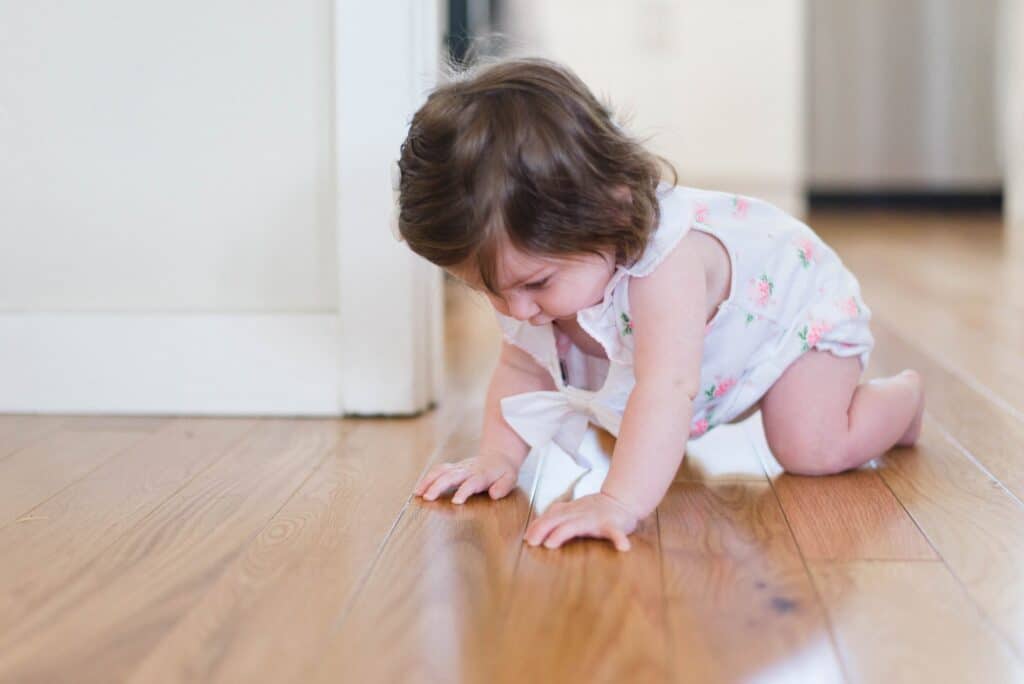Benefits of Crawling
Why is crawling so important? Crawling is an important part of development. Literature indicates there is a strong link between movement, the brain, and learning (Krog, 2015). As a baby begins to move around their environment, they are increasing their awareness of their surroundings, fostering their sensory-motor development as they begin to touch, explore, and see new experiences. Crawling also provides a strong foundation for the development of higher-level motor skills. Here are the many benefits of why:
Crawling helps a baby develop strength and stability. A stable core and adequate shoulder stability is critical for the development of fine motor skills. It will help with the progression of grasping patterns, and even your child’s pencil grasp as they grow!
Crawling promotes bilateral coordination. Bilateral coordination refers to the ability to coordinate both the upper and lower body, as well as both left and right sides of the body in an integrated and fluid manner. It is an important developmental skill, as it indicates both sides of the brain are communicating and working together to efficiently complete tasks. Many everyday tasks require the use of efficient bilateral coordination, including walking, catching a ball, using scissors, dressing, writing, feeding, and so much more!
Crawling promotes sensory-motor development. When a baby is crawling, they are weight-bearing through their hands and upper extremities. Not only is this important for building strength, but it provides opportunity for deep-pressure proprioceptive input (input into the muscles, joints, and ligaments). Once they begin crawling and exploring their environment, they are touching and feeling new textures (i.e., changing surfaces from carpet to wood floor, or exploring with new toys), and seeing their environment from a new perspective. As they change head positions or engage in transitional movements, they are activating their vestibular system (sense of movement and balance). All wonderful experiences for development and providing “food” for their brains to grow!
Not to mention the many other benefits, including building eye-hand coordination, visual tracking, problem solving, balance, and more!
When beginning to crawl, a baby may start “belly crawling” where their belly remains on the floor. Then, they may progress to crawling on all four’s, weight-bearing on their hands and knees with their stomach off the floor. Sometimes, babies find crawling challenging and may find an “easier” way to move around. While it may be exciting when a baby begins to stand or walk, the crawling phase is still an important and beneficial part of development.
Here are some tips to promote crawling:
-
Tummy time, tummy time, tummy time! When your baby is alert and awake, play with them and encourage tummy time. As pediatric occupational therapists, we love engaging in activities in “prone” position, or laying on the stomach, propped up on forearms and head upright. There are many benefits to this position, and it is the start of your baby learning to pick their head up against gravity – imagine how much work that can be for your little one! If your baby is having a difficult time with tummy time, do not feel discouraged. Try briefer time periods throughout the day, or modified positions such as placing your baby on your chest. As your baby becomes stronger, they may begin to tolerate longer periods of tummy time.
-
Motivation!
-
Place toys around your baby to promote pivoting
-
Use preferred, favorite toys. Engaging toys with high contrast colors or singing. Mirrors are a great addition!
-
Begin with items slightly out of reach to encourage reaching and movement. Toys that roll away, facilitate them moving naturally to retrieve them.
-
Place toys slightly above the floor to facilitate your baby moving their head and looking up
Crawling is a complex, yet important skill. Have questions? Speak with your baby’s health care provider and consult with a licensed occupational therapist for more information.
Written by: Maria Cerase, MS, OTR/L
Reference
Krog, S. (2015). Movement activities: A critical link in developing motor skills and learning in early childhood. African Journal for Physical Health Education, Recreation and Dance, 21(1.2), 426-443. https://hdl.handle.net/10520/EJC-d245a98e7

